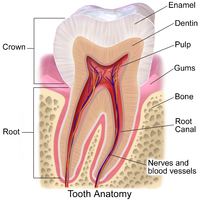
Photo from wikipedia
AIM To evaluate ex vivo the effect of several simulated pulpal blood flow rates on the change in pulp chamber temperature during direct fabrication of a provisional restoration using a polymethylmethacrylate… Click to show full abstract
AIM To evaluate ex vivo the effect of several simulated pulpal blood flow rates on the change in pulp chamber temperature during direct fabrication of a provisional restoration using a polymethylmethacrylate (PMMA) resin. METHODOLOGY Fifteen noncarious human premolars were prepared for complete coverage restorations. A curved needle connected to a peristaltic pump simulated the pulp blood flow. Two K-type thermocouples connected to a digital thermometer were placed in the pulp chamber, and the assembly was placed in an incubator at 37 °C. Three provisional crowns were made for each specimen using no water flow (group 1), a 1-mL min-1 flow rate (group 2) and a 0.5-mL/min-1 flow rate (group 3). The pulp chamber temperature was recorded continuously during polymerization until the temperature increase peaked and started to decrease and reached the baseline temperature (37 °C). The temperature increase was measured for the three water flow conditions. Data were analysed statistically using descriptive statistics, repeated measures one-way analysis of variance (anova) with Greenhouse-Geisser correction and Bonferroni tests. The level of significance was set at P < 0.05. RESULTS All of the groups were associated with an increased pulp chamber temperature. Groups with flow rates at 1 and 0.5 mL min-1 had a significantly lower temperature rise when compared to the group without water flow (P < 0.001). CONCLUSIONS Direct fabrication of provisional restorations can cause a critical increase in pulp chamber temperature. However, in the presence of simulated pulpal blood flow rates of 1 or 0.5 mL min-1 , the increase in pulp chamber temperature did not exceed the critical threshold (5.6 °C).
Journal Title: International Endodontic Journal
Year Published: 2017
Link to full text (if available)
Share on Social Media: Sign Up to like & get
recommendations!